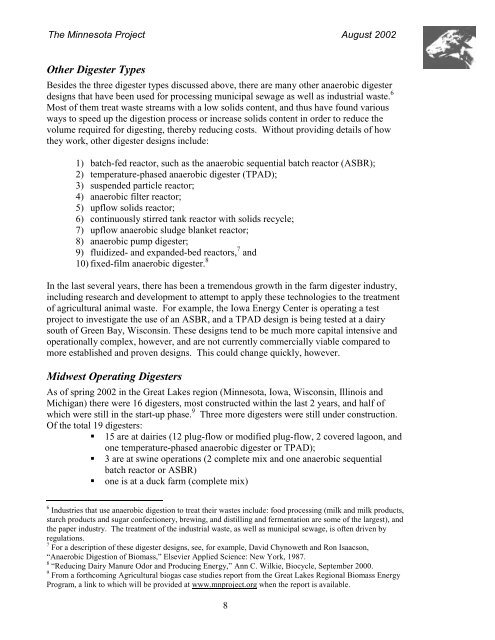Haubenschild Farms Final Report - The Minnesota Project
Haubenschild Farms Final Report - The Minnesota Project
Haubenschild Farms Final Report - The Minnesota Project
Create successful ePaper yourself
Turn your PDF publications into a flip-book with our unique Google optimized e-Paper software.
<strong>The</strong> <strong>Minnesota</strong> <strong>Project</strong> August 2002<br />
Other Digester Types<br />
Besides the three digester types discussed above, there are many other anaerobic digester<br />
designs that have been used for processing municipal sewage as well as industrial waste. 6<br />
Most of them treat waste streams with a low solids content, and thus have found various<br />
ways to speed up the digestion process or increase solids content in order to reduce the<br />
volume required for digesting, thereby reducing costs. Without providing details of how<br />
they work, other digester designs include:<br />
1) batch-fed reactor, such as the anaerobic sequential batch reactor (ASBR);<br />
2) temperature-phased anaerobic digester (TPAD);<br />
3) suspended particle reactor;<br />
4) anaerobic filter reactor;<br />
5) upflow solids reactor;<br />
6) continuously stirred tank reactor with solids recycle;<br />
7) upflow anaerobic sludge blanket reactor;<br />
8) anaerobic pump digester;<br />
9) fluidized- and expanded-bed reactors, 7 and<br />
10) fixed-film anaerobic digester. 8<br />
In the last several years, there has been a tremendous growth in the farm digester industry,<br />
including research and development to attempt to apply these technologies to the treatment<br />
of agricultural animal waste. For example, the Iowa Energy Center is operating a test<br />
project to investigate the use of an ASBR, and a TPAD design is being tested at a dairy<br />
south of Green Bay, Wisconsin. <strong>The</strong>se designs tend to be much more capital intensive and<br />
operationally complex, however, and are not currently commercially viable compared to<br />
more established and proven designs. This could change quickly, however.<br />
Midwest Operating Digesters<br />
As of spring 2002 in the Great Lakes region (<strong>Minnesota</strong>, Iowa, Wisconsin, Illinois and<br />
Michigan) there were 16 digesters, most constructed within the last 2 years, and half of<br />
which were still in the start-up phase. 9 Three more digesters were still under construction.<br />
Of the total 19 digesters:<br />
! 15 are at dairies (12 plug-flow or modified plug-flow, 2 covered lagoon, and<br />
one temperature-phased anaerobic digester or TPAD);<br />
! 3 are at swine operations (2 complete mix and one anaerobic sequential<br />
batch reactor or ASBR)<br />
! one is at a duck farm (complete mix)<br />
6 Industries that use anaerobic digestion to treat their wastes include: food processing (milk and milk products,<br />
starch products and sugar confectionery, brewing, and distilling and fermentation are some of the largest), and<br />
the paper industry. <strong>The</strong> treatment of the industrial waste, as well as municipal sewage, is often driven by<br />
regulations.<br />
7 For a description of these digester designs, see, for example, David Chynoweth and Ron Isaacson,<br />
“Anaerobic Digestion of Biomass,” Elsevier Applied Science: New York, 1987.<br />
8 “Reducing Dairy Manure Odor and Producing Energy,” Ann C. Wilkie, Biocycle, September 2000.<br />
9 From a forthcoming Agricultural biogas case studies report from the Great Lakes Regional Biomass Energy<br />
Program, a link to which will be provided at www.mnproject.org when the report is available.<br />
8
















